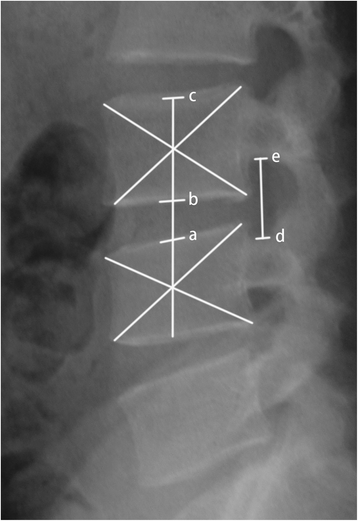Interspinous process stabilization with Rocker via unilateral approach versus X-Stop via bilateral approach for lumbar spinal stenosis: a comparative study
- PMID: 26522063
- PMCID: PMC4629402
- DOI: 10.1186/s12891-015-0786-9
Interspinous process stabilization with Rocker via unilateral approach versus X-Stop via bilateral approach for lumbar spinal stenosis: a comparative study
Abstract
Background: Rocker is a novel interspinous process stabilization (IPS) that can be installed via unilateral approach by virtue of its unique design. This controlled study compared the clinical outcome of Rocker versus X-Stop to access the feasibility and validity of the novel IPS.
Methods: From March 2011 to September 2012, 32 patients treated with Rocker and 30 patients treated with X-Stop were enrolled in this study. The primary clinical outcome measure was Oswestry Disability Index (ODI) score. The secondary clinical outcome measure was Japanese orthopaedics association (JOA) score. Disc height index (DHI) and foraminal height index (FHI) were measured for postoperative radiographic evaluation. Implant failures were also recorded.
Results: There were 55 patients with complete data during 24 months follow-up. Among the 55 patients, 38 patients underwent IPS in combination with microdecompression. At the final follow-up, 49 patients achieved a minimal clinical important difference (≥ 8 points ODI improvement). The mean operative time was 53.6 min (range, 30 to 90 min) in Rocker group and 63.1 min (range, 30 to 100 min) in X-Stop group. The average blood loss was 111 ml (range, 50 to 400 ml) in Rocker group and 138 ml (range, 50 to 350 ml) in X-Stop group. ODI score were significantly improved from preoperative 46.8 ± 9.2 to 12.2 ± 2.6 at 24 months follow-up in the Rocker group and from preoperative 45.8 ± 9.8 to 11.8 ± 2.4 at 24 months follow-up in the X-Stop group. JOA score also improved significantly in both groups. The radiographic parameters of DHI and FHI in both groups increased immediately postoperatively, however, the improvements seemed to revert toward initial value during follow-up. Two patients in Rocker group demonstrated implant dislocation within one week postoperatively and one patient in X-Stop group demonstrated implant migration at two months postoperatively.
Conclusions: Preliminary clinical and radiographic outcome was similar between Rocker and X-Stop group. For patients of lumbar spinal stenosis with unilateral nerve root involved or mild-to-moderate central canal stenosis, Rocker offers a new alternative with less damage.
Figures






References
-
- Hasegawa T, An HS, Haughton VM, Nowicki BH. Lumbar foraminal stenosis: critical heights of the intervertebral discs and foramina. A cryomicrotome study in cadavera. J Bone Joint Surg Am. 1995;77:32–8. - PubMed
Publication types
MeSH terms
LinkOut - more resources
Full Text Sources
Other Literature Sources
Medical

